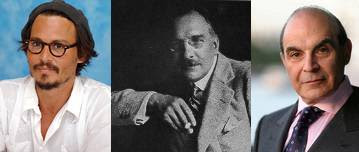Another day, another curiously contentful blog to set me thinking: this time it’s Alterati, “The Inside Scoop on The Outside Culture”, and specifically a two-part article there from October 2007 entitled “The Yellow Sign: Manuscripts, Codices, and Grimoires“.
In Part 1, the discussion swoops from our old friend the Codex Seraphinianus (yet again), to Borges’ Tlön, Uqbar, Orbis Tertius, to Newbold’s claimed microscopic writing in the VMs, and then on to a powerful idea: that “a void, the right void, will spontaneously generate a stop-gap if there’s enough market pressure“, i.e. given sufficient market demand to scratch an itch, people will start selling backscratchers.
“Or perhaps ideas manifest themselves – the more real an idea is the quicker it pops into existence in library-space […]. I still think of grimoires as notes from a journey rather than road maps but I’m now also starting to think of these books as emergent properties of a weird market pressure which demands sources for belief systems“: i.e. given sufficient ‘market demand’ for a religion, books claiming to be the sources of those religions will spontaneously appear.
Here, I suspect the Alterati blogger is thinking about the legend surrounding the Codex Gigas (because that’s what he goes on to discuss), but that seems a little dubious: just about all of the Codex Gigas is mundane, if not actually dull (there’s a set of hi-res scans here, the famous devil picture is on p.290, but big deal, I say). However, it’s actually far closer to the truth with The Grand Grimoire, which is supposed to date to 1522 but which seems to scratch a peculiarly 19th century itch.
In Part 2, the focus shifts to Roman Polanski’s The Ninth Gate, a film I really enjoyed but thought no more than a piece of celluloid mythmaking, a seductive summoning-up of the taste of the Devil’s sulphurous kiss to titillate and amuse. However, I had no idea at all that it was based upon a book – The Club Dumas by Arturo Perez-Reverte. Fascinating stuff! (And yes, I’ve already ordered myself a copy). There’s also a set of the engravings from the film online.
After various idle speculations on the Lovecraftian mythos, our Alterati blogger friend wonders whether the mysterious roving figure of Corso (the book dealer / detective in The Ninth Gate / Club Dumas) is actually based on Wilfrid Voynich. Hmmm… Wilfrid Voynich, as played by Johnny Depp? It’s fairly sublime (I get more of a David Suchet vibe): but perhaps I’m wrong…

Just watching the Ninth Gate on German TV. The similarity with Voynich is more than just a little bit striking!! “Conning people into selling him valuable antique books for a low price” (wikipedia). And then this portrait:
http://www.voynich.nu/img/gallery/wmv_ca_1885.jpg
http://www.cinemaparadiso.co.uk/rentals/the-ninth-gate-2057.html (just one of scores of examples).
The character for Voynich in the 2009 Austrian documentary was selected based on the same picture. He was working in a post office in Cesky Krumlov visited by the producers of the film, where they recognised his similarity and convinced him to take on the role. He didn’t speak a word of English or German….